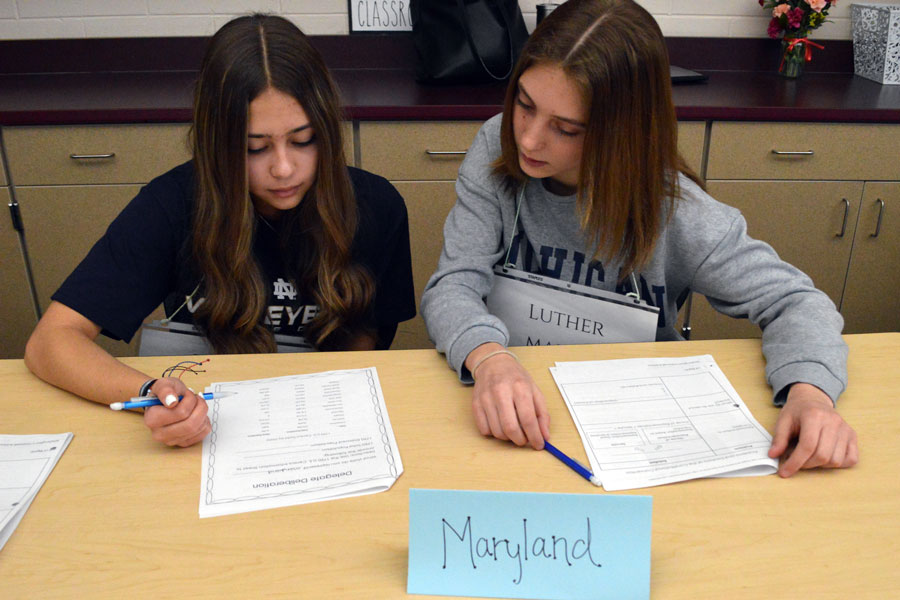Byron Center— Imagine a middle-school classroom transformed into the Pennsylvania State House in 1787 with delegates ready for debate. The central question: How should the United States government be structured?
Two houses, with representation based on population, proposed Mackenzie Schichtel as Edmund Randolph, delegate from Virginia.
One house with each state having one vote, said Tate Pellow, as William Patterson, delegate from New Jersey.
Teacher Allie Burkhardt challenged students to remember why the differences in those plans mattered as they simulated state delegates at the Constitutional Convention supporting either the Virginia Plan or the New Jersey Plan.
“We would probably want the Virginia Plan because we are one of the bigger states and we want more representation,” said Autumn Geib, who played delegate Daniel Carroll, of Maryland.
“We have a small population and we still want to have equal representation with other voters in Congress,” said Tate, about supporting the New Jersey Plan.
The students also considered another crucial factor – whether slaves should count in population-based representation. Large slave-owning states wanted slaves counted. Smaller free states didn’t, and the debate ultimately led to the three-fifths compromise.
The Work Behind the U.S Constitution
West Middle School students have become quite the Constitutional scholars this year as they delve deep into study on how founders planned the U.S. government and the political and economic reasons behind many of their decisions. They are not just learning facts and timelines, but role-playing as the founders themselves and taking on their various perspectives.
Burkhardt, in her third year teaching eighth-grade history at West Middle, said it’s lessons like this that can lead to real understanding of the nation’s founding, and she wants to continue to emphasize the importance of engaging history instruction. She is a recipient of the James Madison Fellowship, awarded to one teacher in each state each year to support better teaching of the U.S. Constitution and the founding principles and documents.
Burkhardt will receive up to $24,000 toward her master of arts degree in teaching American history and government at Ashland University, in Ohio, which she is currently pursuing. She will also attend a four-week summer institute, “The Foundations of American Constitutionalism,” in Washington D.C. to enhance her teaching.
‘As historians, we can’t really understand history unless we know all the context, all the perspectives that could have influenced what course was charted in history.’
– Eighth-grade teacher Allie Burkhardt
Burkhardt’s love for American history began in elementary school, thanks to an innovative teacher. “I have a vivid memory from fourth grade – Mrs. Miller’s class,” said Burkhardt, who graduated from Grandville Public Schools and Hope College.
One day, the class came back from lunch and their kind teacher was suddenly very angry. She told her students to get out a pencil and paper and copy a list of new rules she frantically wrote on the board.
“After a few minutes, she could tell we were anxious and wondering what on earth was going on,” Burkhardt said. “She likened it to the king placing a bunch of new rules on the colonists. I just thought that was the coolest simulation; It was the coolest new topic.
“Since then, I’ve loved American history. I’ve always known I wanted to teach it. I try, like (Mrs. Miller), through simulations and debates to make it come alive as much as possible and get students involved in history.”

Paying Inspiration Forward
She and fellow eighth-grade teacher Rebecca Debowski, are all about making class memorable. “As historians, we really can’t understand history unless we know all the context, all the perspectives that could have influenced what course was charted in history,” Burkhardt said.
“The more that I can get my students to not only read the context but feel the context and hear the context… the better they can understand history and also appreciate why certain decisions were made and why our country’s history looks the way it does.”
Students said they enjoy learning history as if they are playing and meeting the real people who influenced it. “It makes it more fun to learn about history, rather than just sitting down and taking notes,” said Lucas Arthur. “I can visualize it.”
“It’s easier to learn when you are engaged. She makes it more entertaining so we don’t get bored in class,” said Advik Agrawal.
A big focus this summer – and Burkhard’s preparation for it – is on using primary sources in teaching about the Constitution. Those include James Madison’s personal notes and private letters between Alexander Hamilton and George Washington.
The documents provide a first-hand account of how the Constitution came to be and how it was interpreted by the founders, Burkhardt said.
“I have learned so much, and I thought I knew the Constitution and the convention. It’s fascinating to hear their words and what they didn’t like about the Constitution even after it was ratified, and how they interpreted the document. I think it makes it so much more alive and a human document.”
A stipulation of the fellowship is that recipients continue to teach American history for as many years as it took them to get their master’s degree. As for Burkhardt, she’s in it for the long haul. Getting students to understand the importance of the Constitution starts in school.
“You have to give it meaning and value,” she said. “As a teacher, I am trying to make this document as alive and as important, meaningful and valuable as possible.”












